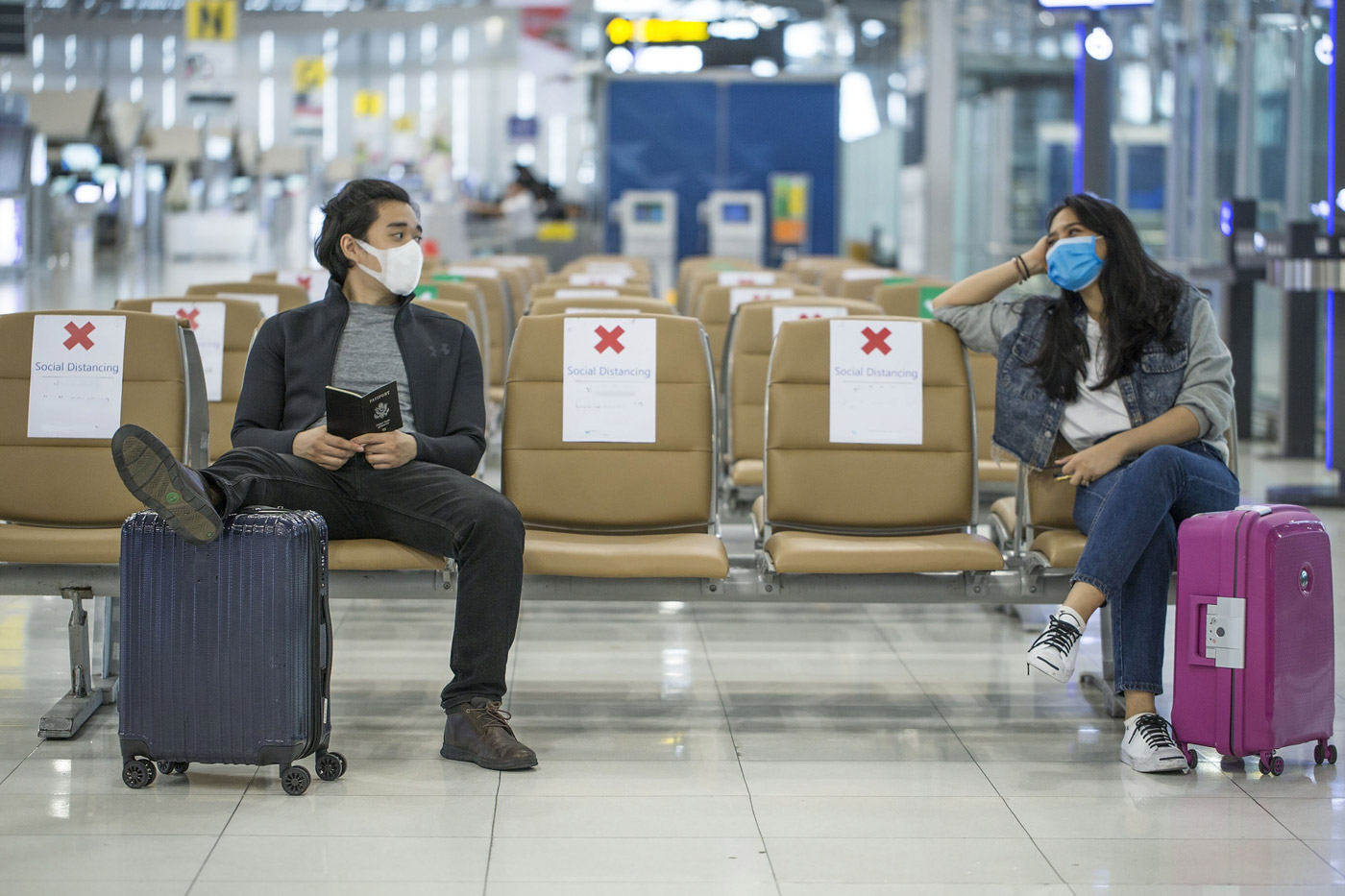We recently welcomed four aviation industry leaders to share their experiences managing the impact of COVID-19 on airport operations, restoring crucial traveler confidence, and identifying opportunities to build that confidence moving forward.
- Andrew Khouw, Indoor Navigation Program Manager at SeaTac International Airport (SEA);
- Jeff Livney, a founder and Chief Experience Officer at Servy, a mobile ordering and payments platform for contactless airport dining and retail;
- Steve Thody, Project Director at Vantage Airport Group, a global airport investment, development, planning, and management firm;
- Campbell Kennedy, co-founder and General Manager of the Atrius Personal Wayfinder product.
During our panel discussion, these aviation experts thoughtfully provided their perspectives on issues confronting today’s airport managers and industry leaders.
How did airports respond to COVID-19?
“Maybe a global pandemic was not at the top of our playbook as far as emergency response, but I think our culture of safety helped us to organize and quickly respond to it,” said Andrew Khouw, when asked how airport teams responded to the pandemic in the early part of 2020. Drawing on existing protocols for safety and communication helped SeaTac managers pivot and address the rapidly changing situation during the early days of the pandemic.
Steve Thody described how Vantage Network Group urgently formed local and network-wide task forces charged with protecting the entire passenger journey. These response teams focused on contact points, interactions between staff and passengers, and physical distancing measures. They assessed which technologies, or new materials, provided the best immediate and extended solutions to capitalize on existing safety practices. Vantage Network Group leadership prioritized communication as the fastest and most useful way forward by reassigning all their digital and static boards to a singular purpose: keeping passengers updated on the latest safety guidelines in all their airports worldwide.
How did COVID-19 affect the need for passenger-friendly technology?
Moving on to how COVID-19 affected industry technology, our panelists agreed that COVID-19 did not change the increasingly tricky task airport operators face of correctly and consistently disseminating information to help travelers. According to Campbell Kennedy, passengers “either have too little time or way too much time, and it’s the job of the airport operators to assist in both of these scenarios.” Technology helps airport teams provide this assistance.
One such example of this is Grab by Servy, introduced by Jeff Livney as an eCommerce mobile ordering platform enabling contactless food order and payment capability for passengers worried about spending too much time in high-traffic concession areas. Consumers have long enjoyed this type of technology for the sake of convenience; now, travelers want more apps that enable contactless interactions for personal safety reasons.
Is the role of technology in the aviation space accelerating?
Travel is stressful for many people, even under the best of circumstances. The pandemic added uncertainty, more stress, and concerns for one’s health to air travel. Our panelists concurred they are prioritizing efforts to enhance travelers’ digital experiences. COVID-19 refocused their strategic planning toward improved digital experiences.
Personal mobile devices are essential traveler tools. Throughout the travel day, passengers can access directions to the airport, gate information, connecting flight updates, and baggage claim carousel numbers from applications installed on cell phones and tablets.
As more passengers return to air travel, it will be even more common to manage the airport and flying experience via mobile apps. “We’ve got an opportunity in this pandemic to innovate and change what the passenger experience looks like,” says Thody. Accelerating the role of technology begins with understanding how well existing digital services meet passenger expectations.

How far does current technology go for today’s traveler?
We continued the discussion by asking the group for their thoughts on technology as airports gradually welcome more travelers back. Khouw suggested technology has always been a critical factor at Seattle-Tacoma as passengers have gravitated toward “that modern tech-heavy solution” for years. Thody concurred, explaining how Vantage Airport Group and LaGuardia management teams started pushing contactless digital experiences even before COVID-19 rewrote the playbook for day of travel engagement. Finding more ways to reach people via web channels before they leave home and with QR codes on facility signage also helps meet traveler preferences for technology that creates a touchless airport journey.
Are operators meeting passenger expectations for contactless travel?
Our panelists agreed that knowing what types of technology and which digital channels flyers prefer is crucial to developing and implementing new software. For example, frequent flyers are more likely to download an airline app than leisure travelers, or those without carrier loyalty. “Airlines have to make a compelling proposition to go and download that app, and there’s so much fatigue now,” said Livney. Fortunately, web-based access to location-specific terminal information is another way to meet travelers’ expectations for a touchless experience without requiring a full app download.
For passengers willing to install new applications, programs such as the flySEA mobile app, with Blue Dot enabled navigation and live checkpoint wait times, help travelers execute a contactless, low-engagement airport journey. Relying on their personal screen for directions and critical information means fewer face-to-face interactions. And while kiosk touchscreens are well-accepted communication tools, today’s travelers may be hesitant to wait in a congested area to use a shared screen.
What is the future of passenger engagement with touchscreens?
Our panel acknowledged kiosk-based check-in, self-directed baggage checks, and even vending machines are commonplace in today’s airports, but as Livney suggests, are not necessarily popular right now. “When all of this started at the beginning of the year, we pretty much turned off all of our kiosks.” Khouw told the group how SeaTac took a different approach, “We bought a whole bunch of simple pencils. We found out that the eraser tips on the pencils worked well with our common use kiosks.” Moving back up the technology ladder, Grab added QR code technology to make their touchscreens user friendly during the pandemic.
“We see a really high adoption rate of people using the QR codes, so they can then space out.” But not everyone recognizes or knows how to use a QR code. As odd as it may sound, some travelers don’t know their mobile device will automatically scan the graphic then show embedded information on their hand-held screen. Kennedy offered that when the kiosk or touchscreen displayed simple directions to “hold your phone camera up to this picture,” usage increased.
How can airlines impact the way passengers use airport spaces?
After discussing the myriad of technologies operators and industry partners such as Grab are using to improve the airport journey, we asked our panelists what role airlines have in affecting how passengers experience airports.
Airlines have high app usage, especially among brand-loyal passengers. And they’re connecting with these customers across multiple online and offline channels: email and texts at different points along the travel journey, push notifications, and QR-embedded signage at the airports. Airlines also use these channels to communicate necessary information such as baggage requirements and gate assignments to passengers well before arriving at the airport.
With their high app usage, Kennedy suggested that airlines help travelers with pre-planning by integrating their mobile platforms with airport apps. “We see pre-planning becoming more important…passengers mapping out their route to understand [how they need to] go through the airport…helps alleviate some of the stress. We see some of those usage patterns within the airline applications.”
Airline, airport, and third-party collaborations
Airlines can further positively affect the airport experience by cooperating with operators and third-party industry vendors to make it easier for travelers to access information from various sources. Livney offered how airport, airlines, third-party technology platforms need to collaborate to build unified experiences, saying,
I think that everyone’s starting to see that for this kind of stuff to be successful, it needs to be a partnership. Airlines and airports need to come together and share in data…stop looking at it [from] a proprietary, ‘I own this passenger’ [perspective]…to really look at what can we all do together to make this a better experience and restore confidence. We’re seeing a big push on that with airports and airlines, really trying to come together…in sort of a systemic way versus looking at it as a proprietary type process. That’s encouraging.
Airlines and airports are symbiotic; one cannot exist without the other. Thody suggests, “Technology is helping to bridge the gap where people can still own their customers, own their proprietary data and process flows, but work more seamlessly [toward] the customer experience. [This is] how we can really round out the passenger journey.”
High-quality 3D maps, location-based contextual search, and wayfinding support for third-party integrations present future opportunities to join aviation industry ecosystems to fill messaging gaps and enhance day of travel experiences.
Moving forward with technology
“From our side,” shared Livney, “We need to have ways for partners to integrate [technology] into the day of travel experience across the fold and web is really the best way to do that. We think it reaches the most people in an easy way.” And QR advancements are part of how aviation partners will reach passengers. For example, Grab recently partnered with AtYourGate to take advantage of new technology that places QR codes on chair armrests. Passengers are finding quiet places to stay put until they board, rather than walking through the airport to find food. Passengers can order in the Grab app and request delivery directly to their seat.
Kennedy suggests that airports adopt technology that converts passenger location information into actionable decisions. “I think there’s a lot of data [and analytics] coming out of passengers using these applications.” Similar to how big-box retailers adapt their stores based on shopper behavior data, operators need to adopt similar technology to learn what passengers are looking for in airports. Kennedy adds, “I think there’s just a big opportunity for airports to review this type of information where the people are going in the airport, what does that flow look like through the airport, and what are they looking for and use that to actually adjust their offering for ancillary revenue. I see that as a big potential with location services.”
For Khouw at SeaTac, virtual queuing is top of his new technology list. “We simply can’t queue up hundreds or thousands of people at our security checkpoints. I just don’t have the space.”
Vantage Airport Group is concentrating on medium- and long-term strategies, including virtual queuing. Providing transparent information and consistent communication is essential, as is linking the emerging technologies with the latest COVID-19 knowledge to improve the passenger journey. “I believe that as the passengers come back and air travel starts to pick up, it will become a more common everyday experience when you travel to use a mobile app or an integrated platform within the airline app as part of your travel journey. I do think we’ve got an opportunity in this pandemic to innovate and change what the passenger experience looks like,” concluded Thody.
As travelers return to airports and flying industry partners need to collaborate on developing and communicating operating procedures that help passengers feel safe and confident. Applying current and emerging technologies to enhance the entire day of travel is critical.
—
Photo credit: Pexels
